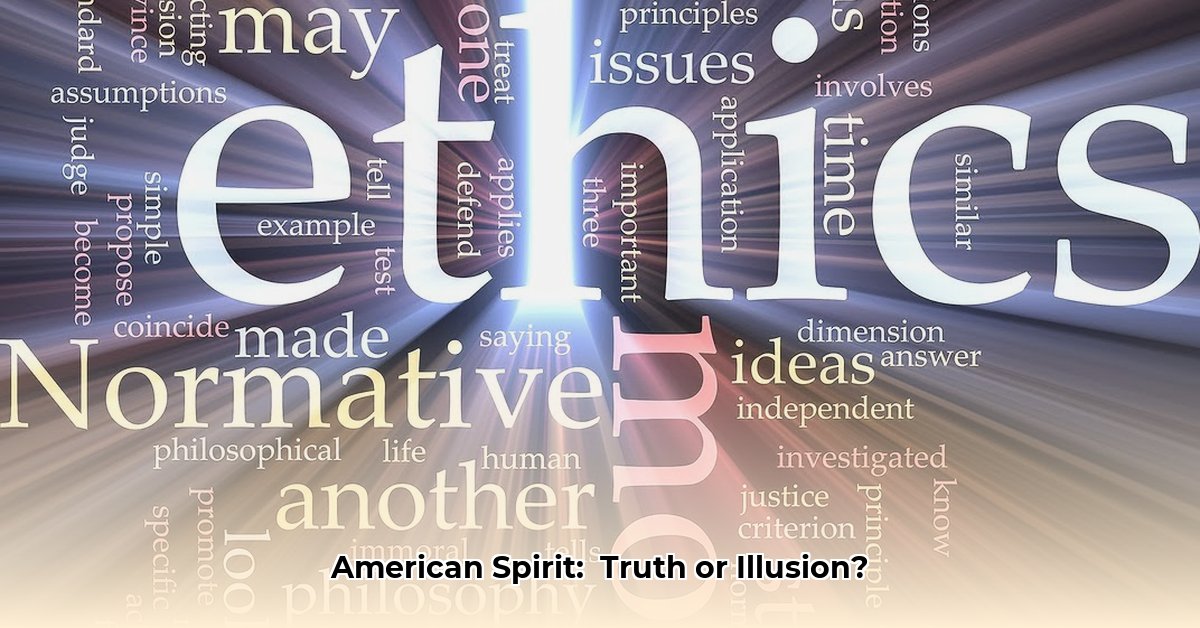American Spirit cigarettes have cultivated an image as a more “natural” and “additive-free” option for smokers. But is this reputation justified, or is it a carefully constructed marketing narrative? This article examines the ethical issues surrounding American Spirit, diving into its marketing tactics, scientific evidence, and cultural implications to reveal the truth behind the brand. For more on FDA involvement, see FDA regulations.
Decoding the “All-Natural” Claim: Marketing vs. Reality
American Spirit strategically markets itself as a natural alternative, capitalizing on smokers’ desire for a less harmful cigarette. This strategy, referred to as the “health halo” effect, leads consumers to perceive the brand as inherently better. However, is this perception accurate? Independent studies often reveal that American Spirit cigarettes contain comparable or even higher levels of harmful chemicals and nicotine compared to conventional brands. This discrepancy between marketing and scientific findings raises questions about whether consumers are being intentionally misled. Is the allure of “natural tobacco” truly reflective of a healthier smoking experience, or is it merely a savvy marketing tactic?
The “Additive-Free” Ambiguity: A Lack of Transparency
The term “additive-free” lacks a clear and consistent definition, allowing American Spirit to use it broadly without specifying what constitutes an “additive.” This lack of transparency has drawn scrutiny from regulatory bodies like the FDA, which has issued warning letters and settlements regarding potentially misleading claims. This ambiguity makes it difficult to assess the true ethical implications of the “additive-free” label. Are consumers fully aware of what “additive-free” truly means in the context of tobacco products, or does the vagueness contribute to misconceptions about reduced harm? Keep in mind that even without additives, the combustion process creates thousands of harmful chemicals, including carbon monoxide and formaldehyde. These substances are inherent to burning tobacco, regardless of whether additives are present.
Cultural Appropriation: The Use of Native American Imagery
American Spirit’s branding, featuring Native American imagery, has faced criticism for cultural appropriation. This controversial choice raises questions about respect and sensitivity toward Indigenous communities. Does the brand’s reliance on this imagery perpetuate stereotypes or misrepresent Native American culture? The use of cultural symbols in marketing requires careful consideration to ensure ethical and respectful representation. Several Native American advocacy groups have voiced concerns about the brand’s imagery, arguing that it exploits sacred symbols for commercial gain. This is especially critical when commercializing products associated with adverse health effects.
Evolution of the Brand: From Independent to Corporate
American Spirit’s transformation from a small, independent company to a subsidiary of British American Tobacco (BAT), a global tobacco giant, reflects a broader industry trend. Does this corporate takeover influence the brand’s ethical practices, marketing strategies, or product development? The shift from an independent entity to part of a large corporation can alter the context of ethical considerations. It’s important to consider how corporate influence may impact transparency and accountability. BAT’s global reach and diverse portfolio of tobacco products may lead to a focus on maximizing profits, potentially at the expense of ethical considerations specific to the American Spirit brand.
Stakeholder Impacts: A Comprehensive View
Examining the consequences for different stakeholders provides a fuller understanding of the ethical landscape:
- British American Tobacco (BAT): Must manage legal challenges related to advertising regulations and possibly revise branding strategies. The financial implications of these challenges can be significant, potentially impacting the company’s bottom line and reputation.
- Food and Drug Administration (FDA): Continues monitoring advertising claims and enforcing stricter regulations. The FDA’s role is crucial in protecting public health and ensuring that tobacco companies do not mislead consumers.
- Public Health Organizations: Continue their educational programs and push for industry transparency. These organizations play a vital role in informing the public about the dangers of smoking and advocating for policies that reduce tobacco use.
- Consumers: Need to be increasingly critical of marketing claims and actively seek out reliable, fact-based information. Empowering consumers with knowledge is essential for making informed decisions about their health and well-being.
- Indigenous Communities: The impact of cultural appropriation on Native American communities needs careful consideration. Concerns include perpetuation of stereotypes, misrepresentation of culture, and the commercialization of sacred imagery.
The ethical issues surrounding American Spirit tobacco are complex, necessitating transparent practices, stringent regulations, and a focus on consumer protection. Ongoing scientific and ethical research will continue to shape our understanding of this debate, and the future of ethical tobacco marketing depends on it. Nicotine, a highly addictive substance found in American Spirit cigarettes, is a key factor driving consumer behavior. The addictive nature of nicotine makes it difficult for smokers to quit, even when they are aware of the health risks.
Evaluating the Health Risks of “Additive-Free” Cigarettes
Claims that “organic,” “natural,” or “additive-free” cigarettes are less harmful are not supported by scientific evidence. These claims are deceptive and mirror past marketing strategies the tobacco industry has used. Stronger regulations are needed. Public health officials and medical experts consistently caution against the misconception that these cigarettes pose fewer health risks.
The Mirage of “Additive-Free”
American Spirit cigarettes, marketed as “additive-free,” exemplifies the ethical issues of tobacco marketing. While advertised as lacking additives, the core act of smoking remains harmful. How should consumers evaluate the health risks of these cigarettes? This requires a critical assessment of the marketing claims and a thorough understanding of the scientific evidence.
Dissecting the Marketing Tactics
Terms like “organic,” “natural,” and “additive-free” create illusions of health. These marketing strategies downplay smoking dangers. Even without additives, American Spirit cigarettes still deliver nicotine and thousands of harmful chemicals through burning tobacco. Tar, carbon monoxide, and various carcinogens are all present in the smoke, regardless of the absence of additives.
Regulatory Challenges in the Tobacco Industry
Agencies like the FDA battle misleading marketing. However, the legal landscape allows brands to exploit ambiguities. The history of “light” and “mild” labels demonstrates how terms can mislead consumers by implying reduced harm without scientific backing. The FDA’s regulatory authority is often challenged by legal loopholes and the tobacco industry’s extensive resources.
The Science on “Additive-Free” Cigarettes: Gaps Exist
While “additive-free” claims reduce perceived harm, quantifying the precise impact is hard. Long-term studies are lacking. Therefore, while additives might alter the experience, if it significantly reduces long-term risk is undeterminable. More research is needed to fully understand the impact of specific additives on the overall health risks of smoking.
Evaluating Risks: A Critical Thinking Framework
How should one evaluate the real health risks of “additive-free” cigarettes? Informed skepticism.
- Seek credible information: Consult health organizations like the CDC or WHO. These organizations provide evidence-based information on the health risks of smoking.
- Examine ingredients: Understand the cigarette’s components beyond marketing. This includes researching the potential harms of the tobacco itself and any other substances present.
- Consider long-term impacts: Short-term perceptions do not reflect long-term health consequences. The long-term health risks of smoking include cancer, heart disease, and respiratory illnesses.
- Quit smoking: Quitting is the most effective way to reduce risks. Resources and support are available to help smokers quit, including nicotine replacement therapy and counseling.
The Ethical Imperative: Transparency
The tobacco industry must promote transparency and accurate labeling. This includes avoiding wording that implies a “healthier” cigarette. The goal is for consumers to have complete, factual information. This ethical imperative extends to all aspects of tobacco marketing, from advertising to packaging.
Comparative Analysis of American Spirit’s Marketing Across Regions
American Spirit’s “natural” marketing claims often contain similar—or higher—levels of harmful chemicals compared to conventional brands. This discrepancy influences consumer behavior. A global perspective reveals how marketing strategies are tailored to local regulations and cultural norms.
Decoding the “Natural” Marketing Illusion
Is it accurate? Nicotine and harmful substances are still present—or more present than other brands. This presents an ethical problem; are consumers being tricked? The perception of “natural” can lead consumers to underestimate the risks associated with smoking.
American Spirit’s marketing varies based on geographic regions which targets diverse cultural norms, according to American Spirit Cigarettes: A Comparative Analysis of Marketing Strategies Across Geographic Regions. In regions with strong regulations, this can be downplayed, while in regions with less stringent regulations, the “natural” claims may be more prominent.
Harmful Constituents: Separating Fact from Marketing Fiction
Studies indicate that American Spirit cigarettes have a lot of nicotine, a very addictive substance, along with other carcinogens. Though variations may exist across American Spirit varieties, the overall situation is still concerning. Independent laboratory tests consistently reveal the presence of harmful chemicals in American Spirit cigarettes.
What is the impact of this? Consumers may falsely believe they’re making a better choice, deceiving public health plans. The FDA must evaluate marketing. This can lead to delayed cessation efforts and increased health risks.
Regulations and consumer misinformation
The FDA plays a critical role. Consumers need better education, and regulations may not address “natural” claims. Effective regulation requires a comprehensive approach that addresses all forms of misleading marketing.
Increased transparency is needed, along with improved labeling that makes critical consumer decisions. Clear and accurate labeling can help consumers make informed choices about their health.
Long-Term Implications for Smokers
More research must be done to compare long-term health in various brands. Longitudinal studies are needed to assess the long-term health outcomes of smokers who use American Spirit cigarettes compared to those who use other brands.
Responsible regulation and marketing are needed. American Spirit’s marketing can influence consumer choices, but does not benefit the smoker. Ethical marketing practices should prioritize consumer health
- Lunch Box That Fits Bento Box Neatly for Daily Use - December 5, 2025
- Japanese Lunch Bag Does Double Duty as Bento Carrier and Tote - December 4, 2025
- Your Perfect Bento Box Bag For Fresh And Tidy Meals - December 2, 2025










